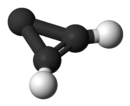- Cyclopropenylidene
-
Cyclopropenylidene 
 Cylcopropenylidene
CylcopropenylideneIdentifiers CAS number 16165-40-5 Jmol-3D images Image 1 - C1=C[C]1
Properties Molecular formula C3H2 Molar mass 38.05 g mol−1  (verify) (what is:
(verify) (what is:  /
/ ?)
?)
Except where noted otherwise, data are given for materials in their standard state (at 25 °C, 100 kPa)Infobox references Cylopropenylidene, or c-C3H2 belongs to a highly reactive class of organic molecules known as carbenes. Due to its reactivity, cyclopropenylidene is only seen terrestrially in the laboratory. However, it is found in significant concentrations in the interstellar medium (ISM) due to the extreme environment. The linear isomer of c-C3H2 is also found in the ISM, but its column density is generally about an order of magnitude lower.[1]
Contents
History
The astronomical detection of c-C3H2 was first confirmed in 1985[2]. Four years earlier, several ambiguous lines had been observed in the radio region of spectra taken of the ISM[3], but the observed lines were not identified at the time. These lines were later matched with a spectrum of c-C3H2 using an acetylene-helium discharge. Surprisingly, c-C3H2 has been found to be ubiquitous in the ISM.[4] Detections of c-C3H2 in the diffuse medium were particularly surprising because of the low densities.[5][6] It had been believed that the chemistry of the diffuse medium did not allow for the formation of larger molecules, but this discovery, as well as the discovery of other large molecules, continue to illuminate the complexity of the diffuse medium. More recently, observations of c-C3H2 in dense clouds have also found concentrations that are significantly higher than expected. This has led to the hypothesis that the photodissociation of polycyclic aromatic hydrocarbons (PAHs) enhances the formation of c-C3H2.[7]
Formation
The major formation reaction of c-C3H2 is the dissociative recombination of c-C3H3+.[8]
- C3H3+ + e- → C3H2 + H
c-C3H3+ is a product of a long chain of carbon chemistry that occurs in the ISM. Carbon insertion reactions are crucial in this chain for forming C3H3+. The protonation of NH3 by c-C3H3+ is the second most important formation reaction. However, under typical dense cloud conditions, this reaction contributes less than 1% of the formation of C3H2.
Destruction
Cyclopropenylidene is generally destroyed by reactions between ions and neutral molecules. Of these, protonation reactions are the most common. Any species of the type HX+ can react to convert the c-C3H2 back to c-C3H3+.[8] Due to rate constant and concentration considerations, the most important reactants for the destruction of c-C3H2 are HCO+, H3+, and H3O+. [9]
- C3H2 + HCO+ → C3H3+ + CO
Notice that c-C3H2 is mostly destroyed by converting it back to C3H3+. Since the major destruction pathways only regenerate the major parent molecule, C3H2 is essentially a dead end in terms of interstellar carbon chemistry. However, in diffuse clouds or in the photodissociation region (PDR) of dense clouds, the reaction with C+ becomes much more significant and C3H2 can begin to contribute to the formation of larger organic molecules.
Spectroscopy
Detections of c-C3H2 in the ISM rely on observations of molecular transitions using rotational spectroscopy. Since c-C3H2 is an asymmetric top, the rotational energy levels are split and the spectrum becomes complicated. Also, it should be noticed that C3H2 has spin isomers much like the spin isomers of hydrogen. These ortho and para forms exist in a 3:1 ratio and should be thought of as distinct molecules. Although the ortho and para forms look identical chemically, the energy levels are different, meaning that the molecules have different spectroscopic transitions.
When observing c-C3H2 in the interstellar medium, there are only certain transitions that can be seen. In general, only a few lines are available for use in astronomical detection. Many lines are unobservable because they are absorbed by the Earth's atmosphere. The only lines that can be observed are those that fall in the radio window. The more commonly observed lines are the 110 to 101 transition at 18343 MHz and the 212 to 101 transition at 85338 MHz of ortho c-C3H2.[4][7][2]
See also
References
- ^ D. Fosse, J. Cernicharo, M. Gerin, P. Cox "Molecular Carbon Chains and Rings in TMC-1" Astrophys. J., 552, 168 (2001)
- ^ a b P. Thaddeus, J. M. Vrtilek, and C. A. Gottlieb "Laboratory and Astronomical Identification of Cyclopropenylidene, C3H2." Astrophys. J. 299 L63 (1985)
- ^ P. Thaddeus, M. Guelin, R. A. Linke "Three New "Nonterrestrial" Molecules" Astrophys. J. 246 L41 (1981)
- ^ a b Lucas, R. and Liszt, H. "Comparative chemistry of diffuse clouds I. C2H and C3H2" Astron. & Astrophys., 358, 1069 (2000)
- ^ H. E. Matthews and W. M. Irvine "The Hydrocarbon Ring C3H2 is Ubiquitous in the Galaxy" Astrophys. J., 298, L61 (1985)
- ^ P. Cox, R. Gusten, and C. Henkel "Observations of C3H2 in the Diffuse Interstellar Medium" Astron. & Astrophys., 206, 108 (1988)
- ^ a b J. Pety et al. "Are PAHs precursors of small hydrocarbons in photo-dissociation regions? The Horsehead case" Astron. & Astrophys., 435, 885 (2005)
- ^ a b S. A. Maluendes, A. D. McLean, E. Herbst "Calculations Concerning Interstellar Isomeric Abundance Ratios for C3H and C3H2" Astrophys. J., 417 181 (1993)
- ^ T. J. Millar, P. R. A. Farquhar, K. Willacy "The UMIST Database for Astrochemistry 1995" Astron. and Astrophys. Sup., 121 139 (1997)
Categories:- Carbenes
Wikimedia Foundation. 2010.
